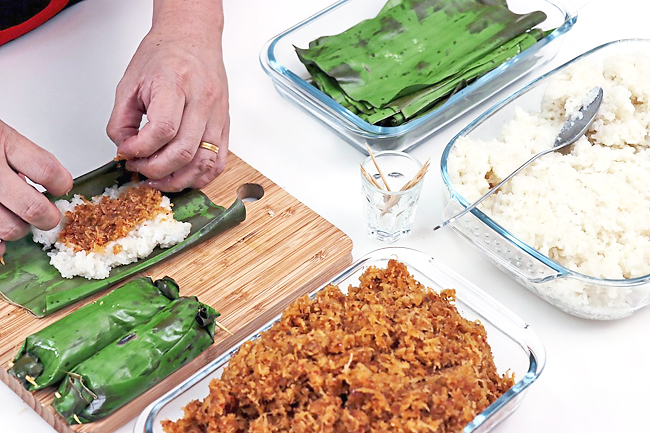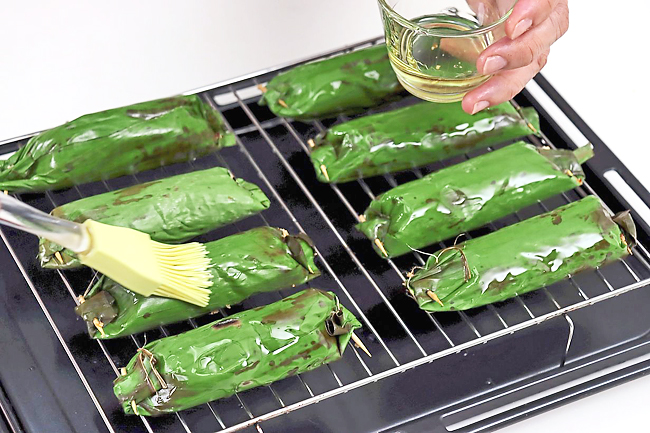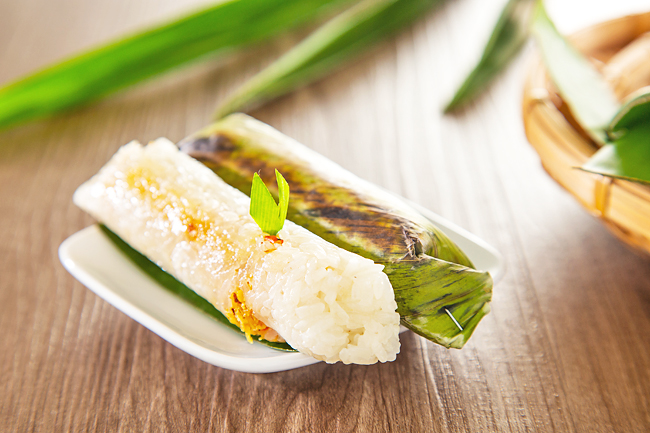ANN/THE STAR – Pulut panggang is a traditional Malay snack that is primarily made of glutinous rice and grated coconut.
It usually also contains dried shrimp but on the east coast of Malaysia, it may be made with fish or anchovies (ikan bilis) in which case it is known as kuih pulut lepa.
Available at most kuih stalls all over the country, and being salty and spicy, it offers an option for those who want an alternative to the sweet desserts.
The pulut panggang rolls can vary from two-four centimetres (cm) in diameter and range from 10-20cm long.
Malay traders tend to offer plump ones, whilst Nyonya kuih sellers often make petite pulut panggang and call them rempah udang.
Traditionally, it is rolled in banana leaf and grilled over charcoal but it has also become common practice to roast them in the oven.
If you have an oven that can be set higher than 250 degrees Celsius (oC), then you should opt for the highest temperature setting to get the distinctive charring on the banana leaf, which also contributes to its flavour.



Before rolling the banana leaves, be sure to wilt them either by scorching them over an open flame, steaming or boiling them.
One of the crucial steps in ensuring the rolls have a soft, pliable texture is to soak the glutinous rice for at least two hours.
While some recipes instruct cooking the rice in coconut milk, others call for a two-step steaming process that ensures the rice is fully cooked before coconut milk is added for the second round of steaming.
After rolling out the cooked rice, you may roast the rolls immediately or freeze them for thawing and roasting later.
However, these rolls should not be kept for more than two weeks because coconut milk and grated coconut can spoil easily.
Remember to brush the parcels with oil before roasting or else the banana leaf will be singed and fall apart.
PULUT PANGGANG
Ingredients
– 600 grammes (g) glutinous rice, rinsed and soaked for two hours
– About two cups cold water
– Two cups coconut milk
– One tablespoon (tbsp) salt to taste
– Filling 80 millilitres (ml) cooking oil
– 100g dried shrimp, coarsely ground
– 120g shallots, chopped
– Three cloves garlic, chopped
– Four stalks lemongrass, finely sliced
– 15g dried chilli flakes
– One tbsp ground fennel seeds
– One tbsp ground coriander seeds
– One tbsp salt to taste
– One grated coconut
– 150g sugar
– 50ml cold water
Directions
Drain glutinous rice and place in a pot or cake tin. Fill with enough cold water to just cover the top of the rice.
Steam over boiling water for 20 minutes until cooked. Fluff the rice with a wooden spoon and stir in coconut milk and salt. Steam for another 15 minutes, stir and allow to cool completely.
For the filling, grind shallots, garlic, lemongrass, chilli flakes, fennel, coriander and salt into a fine paste in an electric mill.
Heat cooking oil to fry dried shrimp until fragrant. Add spice paste to saute until the oil splits.
Add grated coconut, sugar and water and saute until dry. Set aside to cool completely. Wash and wipe dry banana leaves, then cut into 15cm squares. Scorch banana leaves over an open flame until wilted.
Press one heaping tablespoon of steamed glutinous rice into the centre of the banana leaf and shape into a rectangular block of about 6x10cm.
Spread about two teaspoons of filling along the length of the rice block, pressing the filling in to compact it. Then roll the rice into a log with the help of the banana leaf. Secure the ends with half a toothpick to seal the rice and filling.
Brush the rolls with cooking oil. Roast over a charcoal grill until charred or bake in a preheated 250°C oven for 15 minutes.
Allow to cool before serving.






